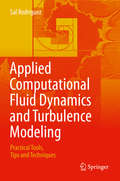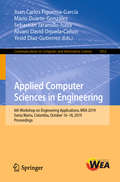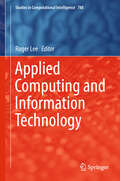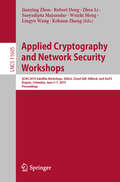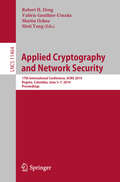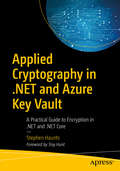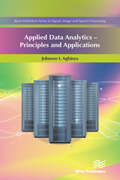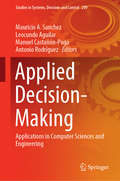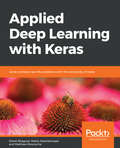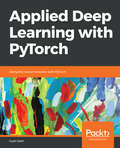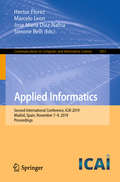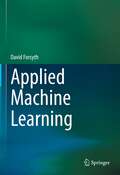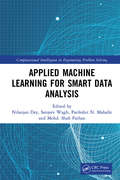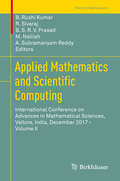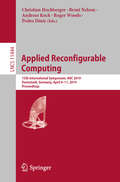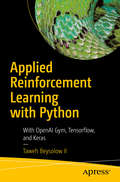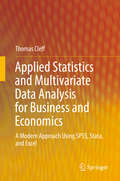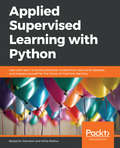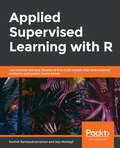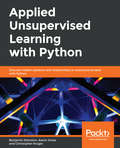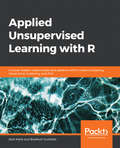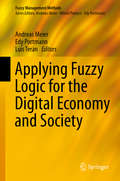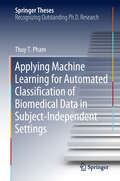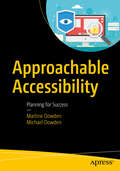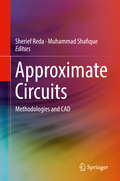- Table View
- List View
Applied Computational Fluid Dynamics and Turbulence Modeling: Practical Tools, Tips and Techniques
by Sal RodriguezThis unique text provides engineering students and practicing professionals with a comprehensive set of practical, hands-on guidelines and dozens of step-by-step examples for performing state-of-the-art, reliable computational fluid dynamics (CFD) and turbulence modeling. Key CFD and turbulence programs are included as well. The text first reviews basic CFD theory, and then details advanced applied theories for estimating turbulence, including new algorithms created by the author. The book gives practical advice on selecting appropriate turbulence models and presents best CFD practices for modeling and generating reliable simulations. The author gathered and developed the book’s hundreds of tips, tricks, and examples over three decades of research and development at three national laboratories and at the University of New Mexico—many in print for the first time in this book. The book also places a strong emphasis on recent CFD and turbulence advancements found in the literature over the past five to 10 years. Readers can apply the author’s advice and insights whether using commercial or national laboratory software such as ANSYS Fluent, STAR-CCM, COMSOL, Flownex, SimScale, OpenFOAM, Fuego, KIVA, BIGHORN, or their own computational tools. Applied Computational Fluid Dynamics and Turbulence Modeling is a practical, complementary companion for academic CFD textbooks and senior project courses in mechanical, civil, chemical, and nuclear engineering; senior undergraduate and graduate CFD and turbulence modeling courses; and for professionals developing commercial and research applications.
Applied Computer Sciences in Engineering: 6th Workshop on Engineering Applications, WEA 2019, Santa Marta, Colombia, October 16–18, 2019, Proceedings (Communications in Computer and Information Science #1052)
by Juan Carlos Figueroa-García Mario Duarte-González Sebastián Jaramillo-Isaza Alvaro David Orjuela-Cañon Yesid Díaz-GutierrezThis volume constitutes the refereed proceedings of the 6th Workshop on Engineering Applications, WEA 2019, held in Santa Marta, Colombia, in October 2019.The 62 revised full papers and 2 short papers presented in this volume were carefully reviewed and selected from 178 submissions. The papers are organized in the following topical sections: computer science; computational intelligence; bioengineering; Internet of things; power applications; simulation systems; optimization.
Applied Computing and Information Technology (Studies in Computational Intelligence #788)
by Roger LeeThis book presents the scientific outcomes of the 6th International Conference on Applied Computing and Information Technology (ACIT 2018), which was held in Kunming, China on June 13–15, 2018. The aim of this conference was to bring together researchers and scientists, businessmen and entrepreneurs, teachers, engineers, computer users, and students to discuss the numerous fields of computer science and to share their experiences and exchange new ideas and information in a meaningful way. The book includes research findings on all aspects (theory, applications and tools) of computer and information science and discusses the practical challenges encountered and the solutions adopted to address them.The book features 13 of the conference’s most promising papers.
Applied Cryptography and Network Security Workshops: ACNS 2019 Satellite Workshops, SiMLA, Cloud S&P, AIBlock, and AIoTS, Bogota, Colombia, June 5–7, 2019, Proceedings (Lecture Notes in Computer Science #11605)
by Lingyu Wang Jianying Zhou Zhou Li Robert Deng Weizhi Meng Suryadipta Majumdar Kehuan ZhangThis book constitutes the proceedings of the satellite workshops held around the 17th International Conference on Applied Cryptography and Network Security, ACNS 2019, in Bogota, Colombia, in June 2019. The 10 papers presented in this volume were carefully reviewed and selected from 30 submissions. They stem from the following workshops:AIBlock 2019: First International Workshop on Application Intelligence and Blockchain SecurityAIoTS 2019:First International Workshop on Articial Intelligence and Industrial Internet-of-Things SecurityCloud S&P 2019:First International Workshop on Cloud Security and PrivacyPriDA 2019:First InternationalWorkshop on Privacy-preserving Distributed Data AnalysisSiMLA 2019: First International Workshop on Security in Machine Learning and its Applications
Applied Cryptography and Network Security: 17th International Conference, ACNS 2019, Bogota, Colombia, June 5–7, 2019, Proceedings (Lecture Notes in Computer Science #11464)
by Moti Yung Robert H. Deng Valérie Gauthier-Umaña Martín OchoaThis book constitutes the refereed proceedings of the 17th International Conference on Applied Cryptography and Network Security, ACNS 2019, held in Bogota, Colombia in June 2019. The 29 revised full papers presented were carefully reviewed and selected from 111 submissions. The papers were organized in topical sections named: integrity and cryptanalysis; digital signature and MAC; software and systems security; blockchain and cryptocurrency; post quantum cryptography; public key and commitment; theory of cryptographic implementations; and privacy preserving techniques.
Applied Cryptography in .NET and Azure Key Vault: A Practical Guide to Encryption in .NET and .NET Core
by Stephen HauntsBenefit from Microsoft's robust suite of security and cryptography primitives to create a complete, hybrid encryption scheme that will protect your data against breaches. This highly practical book teaches you how to use the .NET encryption APIs and Azure Key Vault, and how they can work together to produce a robust security solution. Applied Cryptography in .NET and Azure Key Vault begins with an introduction to the dangers of data breaches and the basics of cryptography. It then takes you through important cryptographic techniques and practices, from hashing and symmetric/asymmetric encryption, to key storage mechanisms. By the end of the book, you’ll know how to combine these cryptographic primitives into a hybrid encryption scheme that you can use in your applications. Author Stephen Haunts brings 25 years of software development and security experience to the table to give you the concrete skills, knowledge, and code you need to implement the latest encryption standards in your own projects.What You'll LearnGet an introduction to the principles of encryptionUnderstand the main cryptographic protocols in use today, including AES, DES, 3DES, RSA, SHAx hashing, HMACs, and digital signaturesCombine cryptographic techniques to create a hybrid cryptographic scheme, with the benefits of confidentiality, integrity, authentication, and non-repudiationUse Microsoft's Azure Key Vault to securely store encryption keys and secretsBuild real-world code to use in your own projectsWho This Book Is ForSoftware developers with experience in .NET and C#. No prior knowledge of encryption and cryptographic principles is assumed.
Applied Data Analytics - Principles and Applications
by Johnson I. AgbinyaThe emergence of huge amounts of data which require analysis and in some cases real-time processing has forced exploration into fast algorithms for handling very lage data sizes. Analysis of x-ray images in medical applications, cyber security data, crime data, telecommunications and stock market data, health records and business analytics data are but a few areas of interest. Applications and platforms including R, RapidMiner and Weka provide the basis for analysis, often used by practitioners who pay little to no attention to the underlying mathematics and processes impacting the data. This often leads to an inability to explain results or correct mistakes, or to spot errors.Applied Data Analytics - Principles and Applications seeks to bridge this missing gap by providing some of the most sought after techniques in big data analytics. Establishing strong foundations in these topics provides practical ease when big data analyses are undertaken using the widely available open source and commercially orientated computation platforms, languages and visualisation systems. The book, when combined with such platforms, provides a complete set of tools required to handle big data and can lead to fast implementations and applications.The book contains a mixture of machine learning foundations, deep learning, artificial intelligence, statistics and evolutionary learning mathematics written from the usage point of view with rich explanations on what the concepts mean. The author has thus avoided the complexities often associated with these concepts when found in research papers. The tutorial nature of the book and the applications provided are some of the reasons why the book is suitable for undergraduate, postgraduate and big data analytics enthusiasts.This text should ease the fear of mathematics often associated with practical data analytics and support rapid applications in artificial intelligence, environmental sensor data modelling and analysis, health informatics, business data analytics, data from Internet of Things and deep learning applications.
Applied Decision-Making: Applications in Computer Sciences and Engineering (Studies in Systems, Decision and Control #209)
by Mauricio A. Sanchez Leocundo Aguilar Manuel Castañón-Puga Antonio RodríguezThis book gathers a collection of the latest research, applications, and proposals, introducing readers to innovations and concepts from diverse environments and systems. As such, it will provide students and professionals alike with not only cutting-edge information, but also new inspirations and potential research directions.Each chapter focuses on a specific aspect of applied decision making, e.g. in complex systems, computational intelligence, security, and ubiquitous computing.
Applied Deep Learning with Keras: Solve complex real-life problems with the simplicity of Keras
by Ritesh Bhagwat Mahla Abdolahnejad Matthew MoocarmeTake your neural networks to a whole new level with the simplicity and modularity of Keras, the most commonly used high-level neural networks API.Key FeaturesSolve complex machine learning problems with precisionEvaluate, tweak, and improve your deep learning models and solutionsUse different types of neural networks to solve real-world problemsBook DescriptionThough designing neural networks is a sought-after skill, it is not easy to master. With Keras, you can apply complex machine learning algorithms with minimum code.Applied Deep Learning with Keras starts by taking you through the basics of machine learning and Python all the way to gaining an in-depth understanding of applying Keras to develop efficient deep learning solutions. To help you grasp the difference between machine and deep learning, the book guides you on how to build a logistic regression model, first with scikit-learn and then with Keras. You will delve into Keras and its many models by creating prediction models for various real-world scenarios, such as disease prediction and customer churning. You’ll gain knowledge on how to evaluate, optimize, and improve your models to achieve maximum information. Next, you’ll learn to evaluate your model by cross-validating it using Keras Wrapper and scikit-learn. Following this, you’ll proceed to understand how to apply L1, L2, and dropout regularization techniques to improve the accuracy of your model. To help maintain accuracy, you’ll get to grips with applying techniques including null accuracy, precision, and AUC-ROC score techniques for fine tuning your model.By the end of this book, you will have the skills you need to use Keras when building high-level deep neural networks.What you will learnUnderstand the difference between single-layer and multi-layer neural network modelsUse Keras to build simple logistic regression models, deep neural networks, recurrent neural networks, and convolutional neural networksApply L1, L2, and dropout regularization to improve the accuracy of your modelImplement cross-validate using Keras wrappers with scikit-learnUnderstand the limitations of model accuracyWho this book is forIf you have basic knowledge of data science and machine learning and want to develop your skills and learn about artificial neural networks and deep learning, you will find this book useful. Prior experience of Python programming and experience with statistics and logistic regression will help you get the most out of this book. Although not necessary, some familiarity with the scikit-learn library will be an added bonus.
Applied Deep Learning with PyTorch: Demystify neural networks with PyTorch
by Hyatt SalehImplement techniques such as image classification and natural language processing (NLP) by understanding the different neural network architecturesKey FeaturesUnderstand deep learning and how it can solve complex real-world problemsApply deep learning for image classification and text processing using neural networks Develop deep learning solutions for tasks such as basic classification and solving style transfer problemsBook DescriptionMachine learning is rapidly becoming the most preferred way of solving data problems, thanks to the huge variety of mathematical algorithms that find patterns, which are otherwise invisible to us. Applied Deep Learning with PyTorch takes your understanding of deep learning, its algorithms, and its applications to a higher level. The book begins by helping you browse through the basics of deep learning and PyTorch. Once you are well versed with the PyTorch syntax and capable of building a single-layer neural network, you will gradually learn to tackle more complex data problems by configuring and training a convolutional neural network (CNN) to perform image classification. As you progress through the chapters, you’ll discover how you can solve an NLP problem by implementing a recurrent neural network (RNN). By the end of this book, you’ll be able to apply the skills and confidence you've gathered along your learning process to use PyTorch for building deep learning solutions that can solve your business data problems.What you will learnDetect a variety of data problems to which you can apply deep learning solutionsLearn the PyTorch syntax and build a single-layer neural network with itBuild a deep neural network to solve a classification problemDevelop a style transfer modelImplement data augmentation and retrain your modelBuild a system for text processing using a recurrent neural networkWho this book is forApplied Deep Learning with PyTorch is designed for data scientists, data analysts, and developers who want to work with data using deep learning techniques. Anyone looking to explore and implement advanced algorithms with PyTorch will also find this book useful. Some working knowledge of Python and familiarity with the basics of machine learning are a must. However, knowledge of NumPy and pandas will be beneficial, but not essential.
Applied Informatics: Second International Conference, ICAI 2019, Madrid, Spain, November 7–9, 2019, Proceedings (Communications in Computer and Information Science #1051)
by Hector Florez Marcelo Leon Jose Maria Diaz-Nafria Simone BelliThis book constitutes the thoroughly refereed papers of the Second International Conference on Applied Informatics, ICAI 2019, held in Madrid, Spain, in November 2019.The 37 full papers and one short paper were carefully reviewed and selected from 98 submissions. The papers are organized in topical sections on bioinformatics; data analysis; decision systems; health care information systems; IT Architectures; learning management systems; robotic autonomy; security services; socio-technical systems; software design engineering.
Applied Machine Learning
by David ForsythMachine learning methods are now an important tool for scientists, researchers, engineers and students in a wide range of areas. This book is written for people who want to adopt and use the main tools of machine learning, but aren’t necessarily going to want to be machine learning researchers. Intended for students in final year undergraduate or first year graduate computer science programs in machine learning, this textbook is a machine learning toolkit. Applied Machine Learning covers many topics for people who want to use machine learning processes to get things done, with a strong emphasis on using existing tools and packages, rather than writing one’s own code.A companion to the author's Probability and Statistics for Computer Science, this book picks up where the earlier book left off (but also supplies a summary of probability that the reader can use).Emphasizing the usefulness of standard machinery from applied statistics, this textbook gives an overview of the major applied areas in learning, including coverage of:• classification using standard machinery (naive bayes; nearest neighbor; SVM)• clustering and vector quantization (largely as in PSCS)• PCA (largely as in PSCS)• variants of PCA (NIPALS; latent semantic analysis; canonical correlation analysis)• linear regression (largely as in PSCS)• generalized linear models including logistic regression• model selection with Lasso, elasticnet• robustness and m-estimators• Markov chains and HMM’s (largely as in PSCS)• EM in fairly gory detail; long experience teaching this suggests one detailed example is required, which students hate; but once they’ve been through that, the next one is easy• simple graphical models (in the variational inference section)• classification with neural networks, with a particular emphasis onimage classification• autoencoding with neural networks• structure learning
Applied Machine Learning for Smart Data Analysis (Computational Intelligence in Engineering Problem Solving)
by Nilanjan Dey Sanjeev Wagh Parikshit Mahalle Mohd. PathanThe book focusses on how machine learning and Internet of Things (IoT) has empowered the advancement of information driven arrangements including key concepts and advancements. Divided into sections such as machine learning, security, IoT and data mining, the concepts are explained with practical implementation including results.
Applied Mathematics and Scientific Computing: International Conference on Advances in Mathematical Sciences, Vellore, India, December 2017 - Volume II (Trends in Mathematics)
by B. Rushi Kumar R. Sivaraj B. S. R. V. Prasad M. Nalliah A. Subramanyam Reddy<p>This volume is the first of two containing selected papers from the International Conference on Advances in Mathematical Sciences (ICAMS), held at the Vellore Institute of Technology in December 2017. This meeting brought together researchers from around the world to share their work, with the aim of promoting collaboration as a means of solving various problems in modern science and engineering. The authors of each chapter present a research problem, techniques suitable for solving it, and a discussion of the results obtained. These volumes will be of interest to both theoretical- and application-oriented individuals in academia and industry. <p>Papers in Volume I are dedicated to active and open areas of research in algebra, analysis, operations research, and statistics, and those of Volume II consider differential equations, fluid mechanics, and graph theory. </p>
Applied Reconfigurable Computing: 15th International Symposium, ARC 2019, Darmstadt, Germany, April 9–11, 2019, Proceedings (Lecture Notes in Computer Science #11444)
by Roger Woods Christian Hochberger Brent Nelson Andreas Koch Pedro DinizThis book constitutes the proceedings of the 15th International Symposium on Applied Reconfigurable Computing, ARC 2019, held in Darmstadt, Germany, in April 2019. The 20 full papers and 7 short papers presented in this volume were carefully reviewed and selected from 52 submissions. In addition, the volume contains 1 invited paper. The papers were organized in topical sections named: Applications; partial reconfiguration and security; image/video processing; high-level synthesis; CGRAs and vector processing; architectures; design frameworks and methodology; convolutional neural networks.
Applied Reinforcement Learning with Python: With OpenAI Gym, Tensorflow, and Keras
by Taweh Beysolow IIDelve into the world of reinforcement learning algorithms and apply them to different use-cases via Python. This book covers important topics such as policy gradients and Q learning, and utilizes frameworks such as Tensorflow, Keras, and OpenAI Gym. Applied Reinforcement Learning with Python introduces you to the theory behind reinforcement learning (RL) algorithms and the code that will be used to implement them. You will take a guided tour through features of OpenAI Gym, from utilizing standard libraries to creating your own environments, then discover how to frame reinforcement learning problems so you can research, develop, and deploy RL-based solutions. What You'll LearnImplement reinforcement learning with Python Work with AI frameworks such as OpenAI Gym, Tensorflow, and KerasDeploy and train reinforcement learning–based solutions via cloud resourcesApply practical applications of reinforcement learning Who This Book Is For Data scientists, machine learning engineers and software engineers familiar with machine learning and deep learning concepts.
Applied Statistics and Multivariate Data Analysis for Business and Economics: A Modern Approach Using SPSS, Stata, and Excel
by Thomas CleffThis textbook will familiarize students in economics and business, as well as practitioners, with the basic principles, techniques, and applications of applied statistics, statistical testing, and multivariate data analysis. Drawing on practical examples from the business world, it demonstrates the methods of univariate, bivariate, and multivariate statistical analysis. The textbook covers a range of topics, from data collection and scaling to the presentation and simple univariate analysis of quantitative data, while also providing advanced analytical procedures for assessing multivariate relationships. Accordingly, it addresses all topics typically covered in university courses on statistics and advanced applied data analysis. In addition, it does not limit itself to presenting applied methods, but also discusses the related use of Excel, SPSS, and Stata.
Applied Supervised Learning with Python: Use scikit-learn to build predictive models from real-world datasets and prepare yourself for the future of machine learning
by Benjamin Johnston Ishita MathurExplore the exciting world of machine learning with the fastest growing technology in the worldKey FeaturesUnderstand various machine learning concepts with real-world examplesImplement a supervised machine learning pipeline from data ingestion to validationGain insights into how you can use machine learning in everyday lifeBook DescriptionMachine learning—the ability of a machine to give right answers based on input data—has revolutionized the way we do business. Applied Supervised Learning with Python provides a rich understanding of how you can apply machine learning techniques in your data science projects using Python. You'll explore Jupyter Notebooks, the technology used commonly in academic and commercial circles with in-line code running support.With the help of fun examples, you'll gain experience working on the Python machine learning toolkit—from performing basic data cleaning and processing to working with a range of regression and classification algorithms. Once you’ve grasped the basics, you'll learn how to build and train your own models using advanced techniques such as decision trees, ensemble modeling, validation, and error metrics. You'll also learn data visualization techniques using powerful Python libraries such as Matplotlib and Seaborn. This book also covers ensemble modeling and random forest classifiers along with other methods for combining results from multiple models, and concludes by delving into cross-validation to test your algorithm and check how well the model works on unseen data.By the end of this book, you'll be equipped to not only work with machine learning algorithms, but also be able to create some of your own!What you will learnUnderstand the concept of supervised learning and its applicationsImplement common supervised learning algorithms using machine learning Python librariesValidate models using the k-fold techniqueBuild your models with decision trees to get results effortlesslyUse ensemble modeling techniques to improve the performance of your modelApply a variety of metrics to compare machine learning modelsWho this book is forApplied Supervised Learning with Python is for you if you want to gain a solid understanding of machine learning using Python. It'll help if you to have some experience in any functional or object-oriented language and a basic understanding of Python libraries and expressions, such as arrays and dictionaries.
Applied Supervised Learning with R: Use machine learning libraries of R to build models that solve business problems and predict future trends
by Jojo Moolayil Karthik RamasubramanianExplore supervised machine learning with R by studying popular real-world uses cases such as object detection in driverless cars, customer churn, and default predictionKey FeaturesStudy supervised learning algorithms by using real-world datasets Fine tune optimal parameters with hyperparameter optimizationSelect the best algorithm using the model evaluation frameworkBook DescriptionR provides excellent visualization features that are essential for exploring data before using it in automated learning. Applied Supervised Learning with R helps you cover the complete process of employing R to develop applications using supervised machine learning algorithms for your business needs. The book starts by helping you develop your analytical thinking to create a problem statement using business inputs and domain research. You will then learn different evaluation metrics that compare various algorithms, and later progress to using these metrics to select the best algorithm for your problem. After finalizing the algorithm you want to use, you will study the hyperparameter optimization technique to fine-tune your set of optimal parameters. To prevent you from overfitting your model, a dedicated section will even demonstrate how you can add various regularization terms.By the end of this book, you will have the advanced skills you need for modeling a supervised machine learning algorithm that precisely fulfills your business needs.What you will learnDevelop analytical thinking to precisely identify a business problemWrangle data with dplyr, tidyr, and reshape2Visualize data with ggplot2Validate your supervised machine learning model using k-fold Optimize hyperparameters with grid and random search, and Bayesian optimizationDeploy your model on Amazon Web Services (AWS) Lambda with plumberImprove your model’s performance with feature selection and dimensionality reductionWho this book is forThis book is specially designed for novice and intermediate-level data analysts, data scientists, and data engineers who want to explore different methods of supervised machine learning and its various use cases. Some background in statistics, probability, calculus, linear algebra, and programming will help you thoroughly understand and follow the content of this book.
Applied Unsupervised Learning with Python: Discover hidden patterns and relationships in unstructured data with Python
by Benjamin Johnston Aaron Jones Christopher KrugerDesign clever algorithms that can uncover interesting structures and hidden relationships in unstructured, unlabeled dataKey FeaturesLearn how to select the most suitable Python library to solve your problemCompare k-Nearest Neighbor (k-NN) and non-parametric methods and decide when to use themDelve into the applications of neural networks using real-world datasetsBook DescriptionUnsupervised learning is a useful and practical solution in situations where labeled data is not available. Applied Unsupervised Learning with Python guides you on the best practices for using unsupervised learning techniques in tandem with Python libraries and extracting meaningful information from unstructured data. The course begins by explaining how basic clustering works to find similar data points in a set. Once you are well versed with the k-means algorithm and how it operates, you’ll learn what dimensionality reduction is and where to apply it. As you progress, you’ll learn various neural network techniques and how they can improve your model. While studying the applications of unsupervised learning, you will also understand how to mine topics that are trending on Twitter and Facebook and build a news recommendation engine for users. You will complete the course by challenging yourself through various interesting activities such as performing a Market Basket Analysis and identifying relationships between different merchandises. By the end of this course, you will have the skills you need to confidently build your own models using Python.What you will learnUnderstand the basics and importance of clusteringBuild k-means, hierarchical, and DBSCAN clustering algorithms from scratch with built-in packagesExplore dimensionality reduction and its applicationsUse scikit-learn (sklearn) to implement and analyse principal component analysis (PCA)on the Iris datasetEmploy Keras to build autoencoder models for the CIFAR-10 datasetApply the Apriori algorithm with machine learning extensions (Mlxtend) to study transaction dataWho this book is forThis course is designed for developers, data scientists, and machine learning enthusiasts who are interested in unsupervised learning. Some familiarity with Python programming along with basic knowledge of mathematical concepts including exponents, square roots, means, and medians will be beneficial.
Applied Unsupervised Learning with R
by Bradford TuckfieldApplied Unsupervised Learning with R is designed for business professionals, who want to learn about methods to understand their data better, and developers, who have an interest in unsupervised learning. It'll help you to have basic, beginner-level familiarity with R, including how to open the R console, how to read data, and how to create a loop. To easily understand the concepts of this book, you should know basic mathematical concepts, such as exponents, square roots, means, and medians.
Applying Fuzzy Logic for the Digital Economy and Society (Fuzzy Management Methods)
by Edy Portmann Andreas Meier Luis TeránThis edited book presents the state-of-the-art of applying fuzzy logic to managerial decision-making processes in areas such as fuzzy-based portfolio management, recommender systems, performance assessment and risk analysis, among others. Presenting the latest research, with a strong focus on applications and case studies, it is a valuable resource for researchers, practitioners, project leaders and managers wanting to apply or improve their fuzzy-based skills.
Applying Machine Learning for Automated Classification of Biomedical Data in Subject-Independent Settings (Springer Theses)
by Thuy T. PhamThis book describes efforts to improve subject-independent automated classification techniques using a better feature extraction method and a more efficient model of classification. It evaluates three popular saliency criteria for feature selection, showing that they share common limitations, including time-consuming and subjective manual de-facto standard practice, and that existing automated efforts have been predominantly used for subject dependent setting. It then proposes a novel approach for anomaly detection, demonstrating its effectiveness and accuracy for automated classification of biomedical data, and arguing its applicability to a wider range of unsupervised machine learning applications in subject-independent settings.
Approachable Accessibility: Planning for Success
by Martine Dowden Michael DowdenUnderstand the realities of modern web accessibility and what considerations should be made to include everyone. There are hundreds of millions of people who are being left out every single day on the web due to disability or circumstance. The purpose of web accessibility is to remove barriers and bring the information, services, and functionality of the web to as many people as possible so they can be included in this global community. This book makes the topic of web accessibility as approachable as possible to help every web professional become an accessibility advocate at their companies, on their projects, and in their communities. This discussion will go beyond the buzzword to explore the impact our designs and decisions have on real people, along with the ethical, legal, and financial incentives for accessibility prioritization. For those who are ready to get started the book covers tools and techniques for testing websites or web applications for conformance to the Web Content Accessibility Guidelines. Because we very rarely work in a vacuum the book also covers how to educate your team or company management on web accessibility as well as persuading them to invest time and money in accessibility. For those looking to start an accessibility practice at their company – or simply to ensure that nothing slips through the cracks – the book includes a guide to creating your very own accessibility action plan. Having a well-documented plan of action is an essential step in the long-term success of any initiative. Get started with web accessibility using Approachable Accessibility today. What You'll LearnDiscover various ways that website design can exclude or even harm usersGain an understanding of the Web Content Accessibility Guidelines (WCAG) 2.1Put together an accessibility action plan for your organizationExplore tools and techniques for evaluating your existing websites Who This Book Is For Web designers and developers who want to know more about web accessibility or just want to know how to get started; tech leaders who need help building an accessibility practice or convincing their company to invest in web accessibility; project managers and owners making scope decisions for a project.
Approximate Circuits: Methodologies and CAD
by Muhammad Shafique Sherief RedaThis book provides readers with a comprehensive, state-of-the-art overview of approximate computing, enabling the design trade-off of accuracy for achieving better power/performance efficiencies, through the simplification of underlying computing resources. The authors describe in detail various efforts to generate approximate hardware systems, while still providing an overview of support techniques at other computing layers. The book is organized by techniques for various hardware components, from basic building blocks to general circuits and systems.
